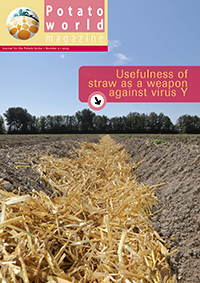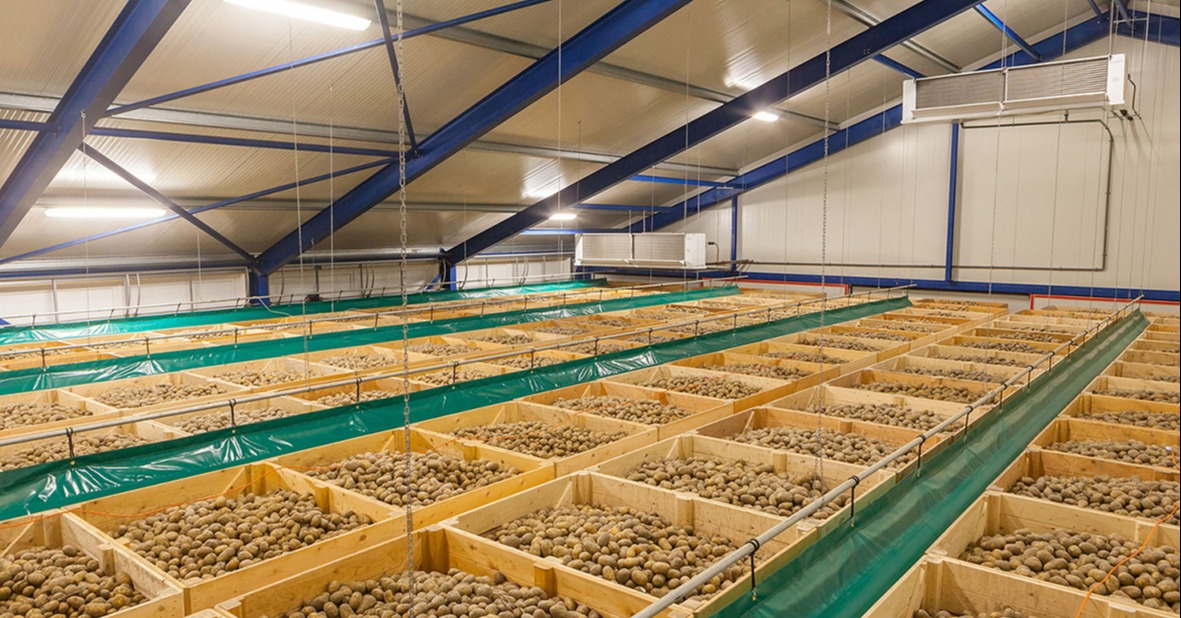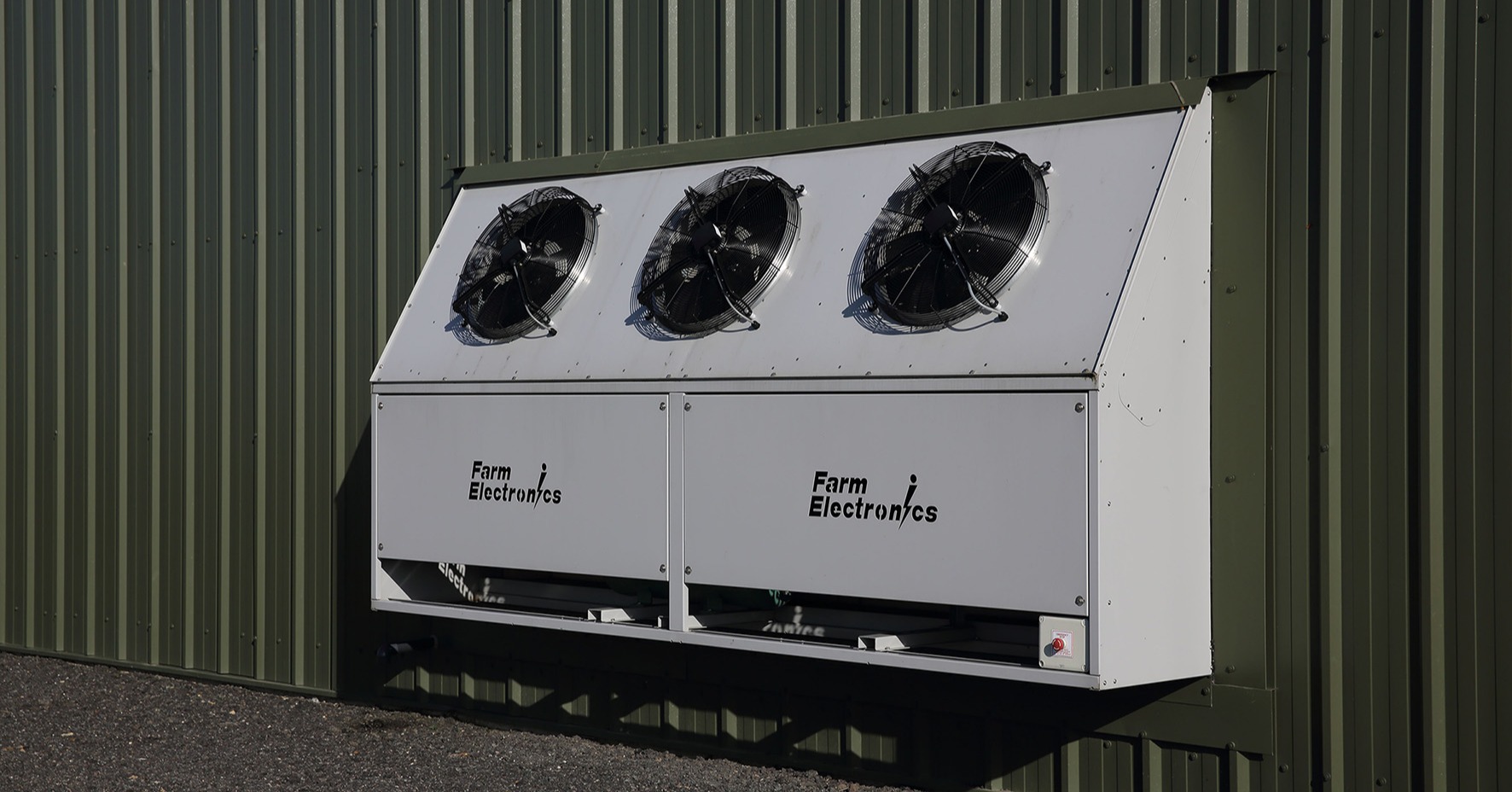Already a subscriber? Activate your premium account

Potatoworld Magazine

If the storehouse is equipped with mechanical cooling, it is possible to cool the tubers quickly to the desired storage temperature. Bringing the tubers to storage temperature, the cooling process, can be done slowly or quickly.
How to make more profit with storage potatoes.
Quick cooling is the best in order to minimise weight loss. However, depending on the destination of the potatoes (seed, table potatoes, French fries or crisps), it is often more desirable to allow cooling to take place more slowly. If the cooling of potatoes before processing happens too fast, there may be a strong accumulation of reducing sugars, which, as mentioned before, has a negative effect on the baking quality. By cooling slowly, at a rate of 0.2 to 0.3 degrees Celsius per day, the build-up of reducing sugars is minimal. A few days with a forecast of higher outside temperatures during the period of cooling can also be a reason for slowing down the process. When the tuber temperature is too low during a period of high outside temperatures, it is not possible to continue drying the potatoes on a daily basis. Any rotten tubers could then start leaking and affect healthy tubers. In such a situation, regular drying is of the utmost importance. If the storehouse is equipped with mechanical cooling, it is possible to cool the tubers quickly to the desired storage temperature. This prevents weight loss and bruising during storage, mainly in table and seed potatoes.
Use the correct cooling system
The use of mechanical cooling is indispensable for the storage of potatoes in many cultivation areas and climate zones. In order to be able to store for long periods of time, in addition to the correct application of sprout inhibitors, a mechanical cooling installation is, in fact, the ideal way to keep storage losses to a minimum. A cooling installation for potatoes is not the same as that for onions or carrots. Although each installation consists of at least a condenser, a compressor, an expansion valve and an evaporator, the specifications of these components can be chosen so as to provide very different cooling installations, while still having the same cooling capacity. However, the one installation will lead to more running hours and weight loss than the other. In order to assess which cooling installation best suits your own potato storage, it makes sense to compare various models before buying one. An important key indicator to take note of is the Coefficient of Performance (COP). This number shows the efficiency of a compressor. The higher the COP, the more efficient the installation. With a cooling installation with a COP of 4, 1 kilowatt (kW) of electrical energy is required to absorb 4 kW of heat in the air cooler/evaporator, the apparatus that can cool (ventilate) air in the storehouse. The COP is defined by a certain condensation and evaporation temperature and depends on the refrigerant used. Refrigerants could be water, ammonia, propane, ethane and CO2. In order to be able to compare COP values, some basic knowledge of cooling systems is required.
Minimise moisture loss
According to the laws of physics, cooling and drying are interconnected. This means that there will always be some loss of moisture during cooling. However, this can be kept to a minimum, for example, by selecting the components of the cooling system in such a way that ventilation takes place with an optimum temperature difference in combination with a relative humidity of 100 percent. The temperature difference over the air cooler/evaporator is greater for onions than for potatoes. Air coolers cool the air by evaporating a liquid. The evaporation process extracts heat from the surroundings, causing the temperature of the air flowing past or through it to drop. Technically, an air cooler/evaporator for onions is cheaper to manufacture than a version for potatoes, because there are fewer requirements regarding the (high) relative humidity in the storage cell.
Moisten for higher storage efficiency if necessary
In countries with a continental climate, where the relative humidity in winter is predominantly low, the storage efficiency can be increased by adding moisture to the ventilation air. This can be done by humidifying the incoming outside air behind the fans. As a result, the relative humidity of the ventilation air increases and when this air comes into contact with the potatoes, the moisture difference is smaller. This way, the ventilation air will extract less moisture from the potatoes and weight loss will be lower. However, moistening is no easy task.

According to the laws of physics, cooling and drying are interconnected. For example, it is very important to ensure that no free moisture enters the storage space with the ventilation air. This can be prevented by atomising the moisture very finely so that it can be absorbed in the air in a short period of time. In practice, this means that when someone holds a hand in front of the atomiser, it should not get wet. This result can often only be achieved with high-pressure installations that guarantee stable operation. The design and control of such humidification systems is a task for specialists in this field.
Want to read more about making profit with storage potatoes? Download our free e-book now!
Events
©2015 - 2024 Potatoworld | Webdesign and realisation COMMPRO